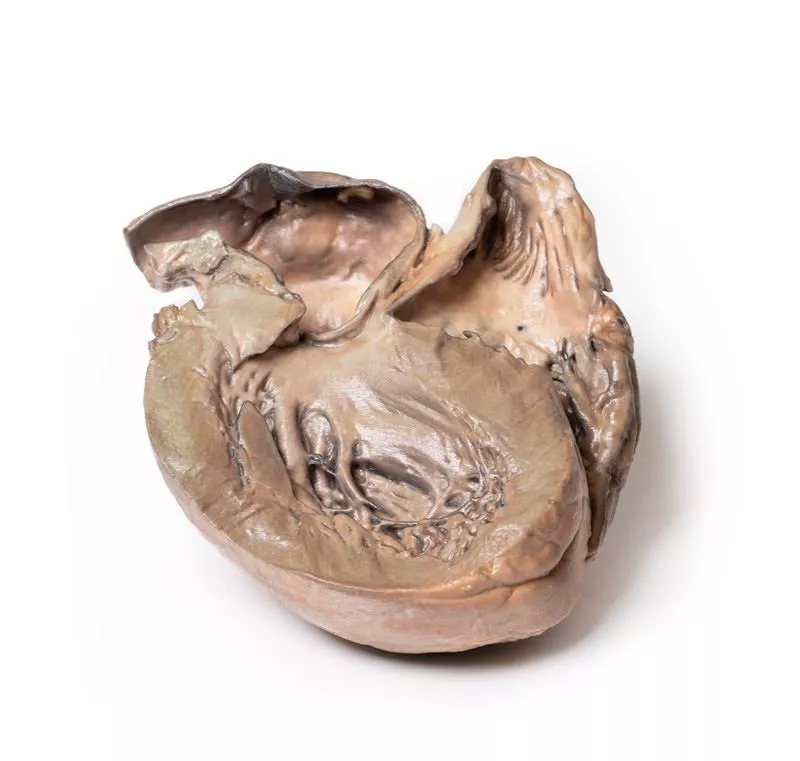Produktinformationen "Syphilitic Aneurysm"
Klinische Vorgeschichte
Ein 61-jähriger Mann stellte sich mit belastungsabhängigem Angina-pectoris-Schmerz und Dyspnoe vor, die sich über 6 Jahre verschlechterten. Bei der Untersuchung zeigte er Zyanose, Tachykardie und einen kollabierenden Puls. Eine Schwellung und ein Pulsationsgeräusch (Thrill) wurden rechts am Hals festgestellt. Der Herzspitzenstoß war inferolateral verlagert. Im Aortenbereich hörte man ein lautes systolisches und diastolisches Geräusch. Das Röntgenbild zeigte eine Kardiomegalie und eine große abgerundete Raumforderung im rechten oberen Mediastinum, die mit dem Herzschatten verbunden war, sowie Hinweise auf Herzversagen. Bluttests waren positiv für Anti-Treponema-Antikörper. Trotz Behandlung verschlechterte sich der Zustand, und der Patient verstarb an Herzversagen.
Pathologie
Das vergrößerte Herzpräparat umfasst den Aortenbogen und die absteigende Aorta. Die aufsteigende Aorta war bis zu 7 cm erweitert, mit einer großen aneurysmatischen Vorwölbung von 11 x 13 cm. Das Aneurysma wurde geöffnet und zeigte eine runzelige, narbige Intima mit ausgeprägter Atheromatose. Der Brachiocephalicus, die linke gemeinsame Halsschlagader und die Arteria subclavia waren durch das Aneurysma nach links verdrängt. Eine 5 mm hohe, kammartige Verdickung auf der inneren Oberfläche markiert den Ansatz des Perikards. Die kleinen Gefäße der Adventitia zeigten eine starke Stauung. Dies ist ein syphilitisches Aneurysma des Aortenbogens.
Weitere Informationen
Syphilis ist eine chronische Infektion durch das Bakterium Treponema pallidum, meist sexuell übertragen, gelegentlich auch angeboren. Risikogruppen sind sexuell aktive Personen, intravenöse Drogenkonsumenten, HIV-Patienten und Männer, die Sex mit Männern haben. Penicillin ist die Hauptbehandlung. Syphilis verläuft in drei Stadien:
- Primäre Syphilis zeigt sich ca. 3 Wochen nach Infektion mit einem schmerzlosen Ulkus (Schanker), das spontan abheilt.
- Sekundäre Syphilis verursacht unspezifische Symptome und Hautausschläge.
- Tertiäre Syphilis tritt Jahre später auf und umfasst kardiovaskuläre Syphilis, Neurosyphilis und Gummata.
Die kardiovaskuläre Syphilis betrifft die Aortitis der aufsteigenden Aorta mit Erweiterung, Aortenklappeninsuffizienz und Aneurysmen durch Endarteritis der Vasa vasorum. Symptome treten meist 15–30 Jahre nach Infektion auf. Die Neurosyphilis verursacht Kopfschmerzen, Sehverlust, Schlaganfälle und kognitive Störungen. Gummatöse Syphilis zeigt sich durch knotige Läsionen an Haut, Knochen und Schleimhäuten, besonders bei HIV-Patienten.
Ein 61-jähriger Mann stellte sich mit belastungsabhängigem Angina-pectoris-Schmerz und Dyspnoe vor, die sich über 6 Jahre verschlechterten. Bei der Untersuchung zeigte er Zyanose, Tachykardie und einen kollabierenden Puls. Eine Schwellung und ein Pulsationsgeräusch (Thrill) wurden rechts am Hals festgestellt. Der Herzspitzenstoß war inferolateral verlagert. Im Aortenbereich hörte man ein lautes systolisches und diastolisches Geräusch. Das Röntgenbild zeigte eine Kardiomegalie und eine große abgerundete Raumforderung im rechten oberen Mediastinum, die mit dem Herzschatten verbunden war, sowie Hinweise auf Herzversagen. Bluttests waren positiv für Anti-Treponema-Antikörper. Trotz Behandlung verschlechterte sich der Zustand, und der Patient verstarb an Herzversagen.
Pathologie
Das vergrößerte Herzpräparat umfasst den Aortenbogen und die absteigende Aorta. Die aufsteigende Aorta war bis zu 7 cm erweitert, mit einer großen aneurysmatischen Vorwölbung von 11 x 13 cm. Das Aneurysma wurde geöffnet und zeigte eine runzelige, narbige Intima mit ausgeprägter Atheromatose. Der Brachiocephalicus, die linke gemeinsame Halsschlagader und die Arteria subclavia waren durch das Aneurysma nach links verdrängt. Eine 5 mm hohe, kammartige Verdickung auf der inneren Oberfläche markiert den Ansatz des Perikards. Die kleinen Gefäße der Adventitia zeigten eine starke Stauung. Dies ist ein syphilitisches Aneurysma des Aortenbogens.
Weitere Informationen
Syphilis ist eine chronische Infektion durch das Bakterium Treponema pallidum, meist sexuell übertragen, gelegentlich auch angeboren. Risikogruppen sind sexuell aktive Personen, intravenöse Drogenkonsumenten, HIV-Patienten und Männer, die Sex mit Männern haben. Penicillin ist die Hauptbehandlung. Syphilis verläuft in drei Stadien:
- Primäre Syphilis zeigt sich ca. 3 Wochen nach Infektion mit einem schmerzlosen Ulkus (Schanker), das spontan abheilt.
- Sekundäre Syphilis verursacht unspezifische Symptome und Hautausschläge.
- Tertiäre Syphilis tritt Jahre später auf und umfasst kardiovaskuläre Syphilis, Neurosyphilis und Gummata.
Die kardiovaskuläre Syphilis betrifft die Aortitis der aufsteigenden Aorta mit Erweiterung, Aortenklappeninsuffizienz und Aneurysmen durch Endarteritis der Vasa vasorum. Symptome treten meist 15–30 Jahre nach Infektion auf. Die Neurosyphilis verursacht Kopfschmerzen, Sehverlust, Schlaganfälle und kognitive Störungen. Gummatöse Syphilis zeigt sich durch knotige Läsionen an Haut, Knochen und Schleimhäuten, besonders bei HIV-Patienten.
Erler-Zimmer
Erler-Zimmer GmbH & Co.KG
Hauptstrasse 27
77886 Lauf
Germany
info@erler-zimmer.de
Achtung! Medizinisches Ausbildungsmaterial, kein Spielzeug. Nicht geeignet für Personen unter 14 Jahren.
Attention! Medical training material, not a toy. Not suitable for persons under 14 years of age.

































